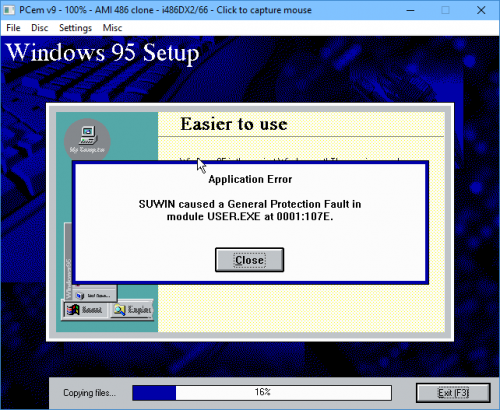First post, by NScaleTransitModels
- Rank
- Newbie
Hello,
New member here but I've been messing around with old hardware for a loooong time, mostly 486s. I just finished cleaning/ upgrading an AST Advantage! Pro 486SX/25 and have been looking into 386 systems to diversity my collection and also as more of a challenge. I bought three new systems, and also brought out my old 486DLC clone. The first one I bought, a 386DX-25 clone, installed Windows 98 (yes, 98 😂) without any problems, but only supported 1mb SIMMs for a total of 8mb memory. My DLC machine also runs 98 fine with 16mb memory.
Since 8mb on a 386 clearly wasn't gonna be enough for me (lol), I bought two more 386 systems that support 4mb SIMMs (32mb total). However, I started getting strange memory errors as soon as I tried to install Windows (95 and 98) on them. Here's what went down:
1. 386DX-33 clone with a HOT-307 motherboard, OPTI 82C382 chipset, and 16mb (4x4mb 9-chip non-parity SIMMs): the Windows 98 setup ran fine until the first restart. After that, every time it tried to detect devices, it would crash with a blue screen of death. The BSoD is different every time, but is always a "fatal exception 0D" or "0E" with some memory address followed by a "VXD". I tried a different set of SIMMs (also 9-chip) and the install was able to finish, but upon restarting, would usually get a similar BSOD within seconds of loading the desktop. I've attached a picture of such a BSoD. Sometimes it would crash w/o errors and soft-reset. A couple times it didn't crash at all, and I could even load up my games. I also tried some brand new 3-chip SIMMs from Ebay, but it would freeze as soon as the mouse showed up.
2. PC Chips M326 motherboard, SARC chipset: I tried both a 386DX-40 and 486DLC-40. At first, it was with 8x 4mb 9-chip SIMMs (32mb), then 4x of those SIMMs (16mb). Same issues as above when installing 98. I then tried 95 with new 3-chip 4mb SIMMs, but no matter the combination, I would get "general protection fault" right after the "welcome to setup" screen. I then went back to 9-chip modules and the first phase of setup completed fine, but like with 98, would again blue screen at "setting up devices". I finally gave in and went back to 3-chip 1mb SIMMs, and the install finally completed (slowly).
At this point I feel like I've tried everything. I searched everywhere (including VOGONS) but nobody seems to be having issues across different memory modules (and especially not new ones). Or with 386s in particular. I'm pulling my hair out because I've never encountered anything like this on a 486 system. Oh, and I got my FX-3000 board today (combo 386/486) to try a newer chipset but it was DOA. 😕😤
Did I miss something obvious? Are 30-pin SIMMs just that unreliable? Did I just get unlucky and end up with 2 bad mobos? Or do neither of their chipsets have stable support for 4mb SIMMs? (Both support 32mb according to stason.org) Apologies for the long post but wanted to make sure I didn't leave out anything obvious.
Builds:
- ECS FX-3000; 386DX-40@50; ET4000AX, ISA 1mb
- Acer VI9; 486DLC-40; Mach32, VLB 2mb
- Chicony CH-471A; CX486s-40; Mach32, VLB 2mb
- Gateway 2000 P5-60; Pentium-60@66; S3 928, PCI 3mb
- DTK PKM-0033S; AM5x86-133@160
